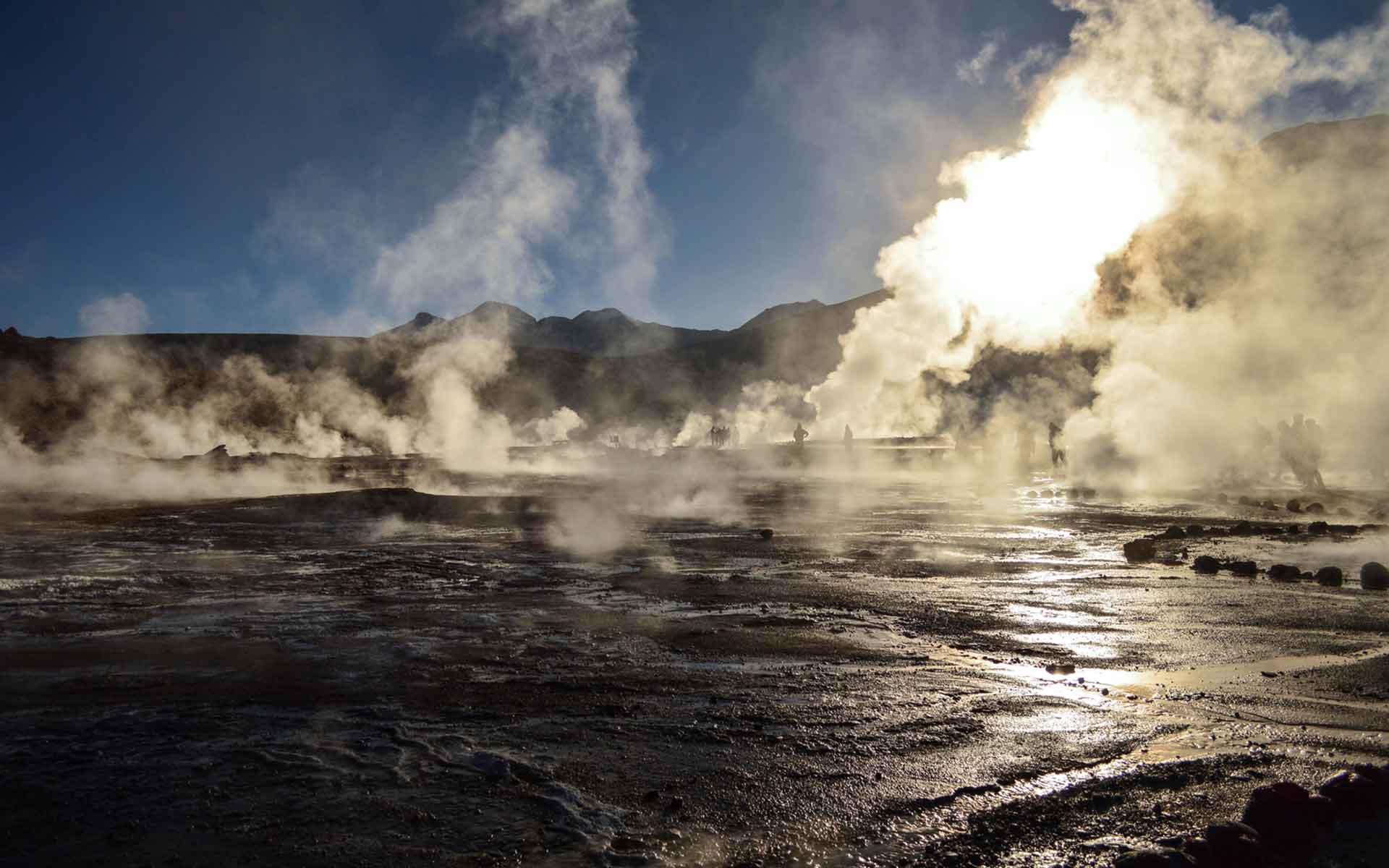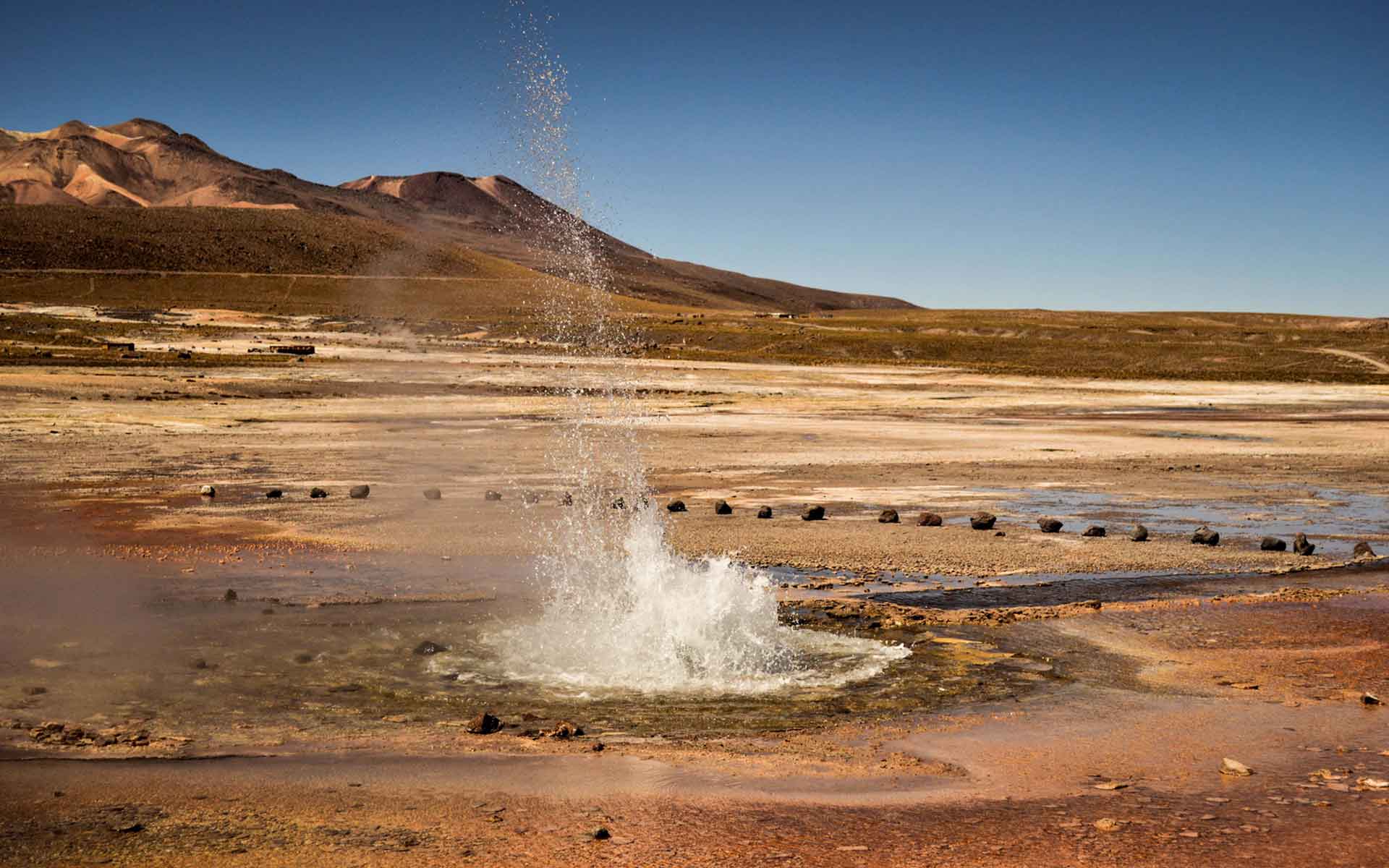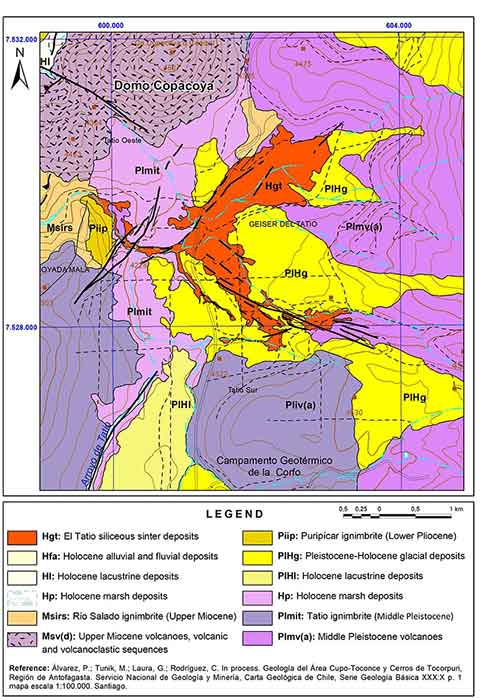
View to the East to the geysers of El Tatio geothermal field (Photo: Daniela Montecinos).
Geological Period
Upper Miocene – Holocene
Main geological interest
Volcanology
Geothermal
Geobiology
Location
Antofagasta Region, Chile.
22°20’06.0″S, 68°00’47.0″W
View to the East to the geysers of El Tatio geothermal field (Photo: Daniela Montecinos).
The largest and most diverse geothermal field in the southern hemisphere with more than a hundred varied major surface manifestations.
El Tatio, one of the world’s highest geyser fields (~4300 m a.s.l.), is a unique environment compared to other hydrotherml localities. Its provides an analouge to conditions of the early Earth and Mars (Phoenix et al., 2006). These conditions are extreme aridity, strong winds, low atmospheric pressure, high UV radiation and daily temperature variations, lower water boiling point (88°C), plus high toxic water concentrations (Wilmeth et al., 2021). The geyser field has one of the highest silica precipitation rates found in the world (Nicolau et al., 2014).
- Geological description
El Tatio is situated in the Altiplano–Puna Volcanic Complex. Surface thermal manifestations (fumaroles, hot springs, sinter cones, perpetual spouters, mud volcanoes and sinter terraces) are located on the upper levels in a Pliocene graben ~4 km wide and 6 km long. The western flank of the graben is the Serranía de Tucle–Loma Lucero horst, and the eastern flank is an alignment of andesitic stratovolcanoes and rhyolitic domes that form the summit of the Andes mountains at this latitude (Fernández-Turiel et al., 2005). The geothermal field is contained in ignimbrites and lavas of the upper Cenozoic that overlies a basement of Mesozoic sedimentary rocks (Glenon and Paff, 2003).
According to geochemical and structural data, the water comes from precipitation in an area located at 12–20 km to the E–SE of El Tatio, and it is heated by volcanic complexes (Pastos Grandes and Cerro Guacha caldera systems) located east of the field (Glenon and Paff, 2003). Hydrothermal manifestations occur over a 30 km2 area, divided into three basins, with most hydrothermal activity concentrated in the Upper Basin of 10 km2. The hot water is mainly confined to two aquifers, which are overlain by volcanic formations (Tucle tuffs and Tatio ignimbrite). The El Tatio episodic hot springs eruptions have a maximum discharge that ranges between 250 to 500 lts/second, depending on seasonal changes; with a mean erupting column height of two meters and a maximum heigth of 8 meters. (Glenon and Paff, 2003; Fernández-Turiel et al., 2005).
- Scientific research and tradition
While remote and with harsh environment, El Tatio was first mentioned in 1885 then 1909, and since 1921 hundred publications, studies and technical reports has been released about El Tatio geothermal field, by scientist around the world related to different aspects (Bertrand, 1885; Nicolau et al., 2014; Wilmeth et al., 2021). Nevertheless, still many questions remain, and numerous research possibilities exist for El Tatio geothermal field, the least known major geothermal system.
- Reference
Bertrand, A. (1885) Memoria sobre las cordilleras del desierto de Atacama y regiones limítrofes, presentada al señor ministro del interior. Santiago, Chile: Imprenta Nacional.
Fernández-Turiel, J.L. et al. (2005) ‘The hot spring and geyser sinters of El Tatio, Northern Chile’, Sedimentary Geology, 180(3), pp. 125–147. Available at: https://doi.org/10.1016/j.sedgeo.2005.07.005.
Glennon, A. and Paff, R.M. (2003) ‘The extraordinary thermal activity of the El Tatio Geysers, Antofagasta Province, Chile’, GOSA Transactions, 8, pp. 31–78.
Nicolau, C., Reich, M. and Lynne, B. (2014) ‘Physico-chemical and environmental controls on siliceous sinter formation at the high-altitude El Tatio geothermal field, Chile’, Journal of Volcanology and Geothermal Research, 282, pp. 60–76. Available at: https://doi.org/10.1016/j.jvolgeores.2014.06.012.
Phoenix, V.R. et al. (2006) ‘Chilean high-altitude hot-spring sinters: a model system for UV screening mechanisms by early Precambrian cyanobacteria’, Geobiology, 4(1), pp. 15–28. Available at: https://doi.org/10.1111/j.1472-4669.2006.00063.x.
Wilmeth, D.T. et al. (2022) ‘Evaporative silicification in floating microbial mats: patterns of oxygen production and preservation potential in silica-undersaturated streams, El Tatio, Chile’, Geobiology, 20(2), pp. 310–330. Available at: https://doi.org/10.1111/gbi.12476.
- Author(s)
Manuel Arenas
National Geological and Mining Service (SERNAGEOMIN), Chile
Felipe Cristian Fuentes Carrasco
Hydrogeology and Geoheritage units. Department of Applied Geology and Geological Resources, National Service of Geology and Mining, Chile


